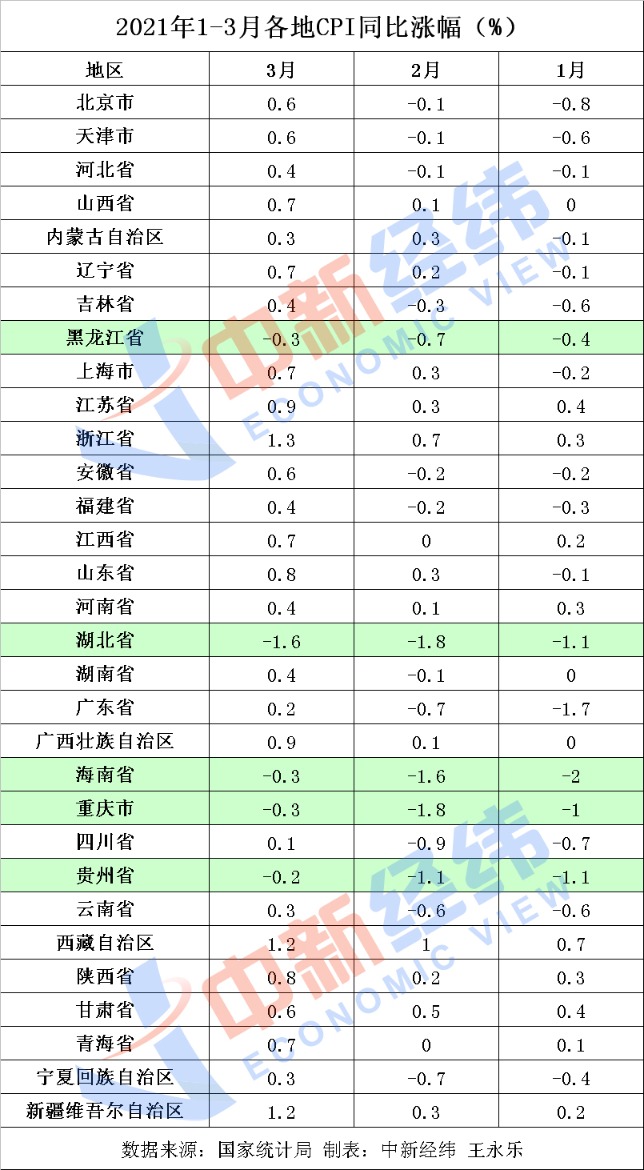原标题:3月发布的31个省CPI:26土地价格上涨!您感觉到了吗?
概括
[31provincesCPIreleasedinMarch:26landpriceshaverisen!Doyoufeelit?TheNationalBureauofStatisticsrecentlyreleasedtheConsumerPriceIndex(CPI)of31provincesinMarch2021ThedatashowedthattheMarchCPIof26provincesincreasedpositivelyyear-on-yearandZhejiangbecametheprovincewiththelargestincreasereaching13%TheCPIoffiveprovincesfellyear-on-yearandHubeihadthelargestdeclinedown16%year-on-year(China-SingaporeJingwei)
The National Bureau of Statistics recently announced 31 provinces in March 2021Consumer Price Index(CPI), data shows that the March CPI of 26 provinces increased positively year-on-year, and Zhejiang became the province with the largest increase, reaching 1.3%. The CPI of five provinces fell year-on-year, and Hubei had the largest decline, down 1.6% year-on-year.
Double! Positive CPI growth in 26 provinces

In March, the national CPI changed from a 0.2% year-on-year decrease to a 0.4% increase from the previous month. From a month-on-month perspective, the CPI fell by 0.5%, and the increase was 1.1 percentage points lower than the previous month.
The Sino-Singapore Jingwei client combed and found that 26 provinces including Zhejiang, Tibet, Xinjiang, Beijing, Tianjin, Hebei, Shanxi, and Shanghai recorded positive growth in March CPI year-on-year, and the number of positive growth provinces was compared with the previous month (13 provinces) Doubled. Five provinces including Guizhou, Heilongjiang, Hainan, Chongqing, and Hubei had negative growth.
Among the 26 provinces with positive growth mentioned above, 16 provinces including Zhejiang and Tibet have experienced growth rates exceeding the national level, while five provinces including Hebei and Jilin have achieved growth rates that are the same as the national level. In addition, 11 provinces, including Beijing, Tianjin, Anhui, Hebei, Jilin, Fujian, Hunan, Yunnan, Ningxia, Guangdong, and Sichuan, turned positive from negative to positive.
In addition, in the five provinces with negative growth mentioned above, the year-on-year decline in CPI in March all narrowed compared to the previous month. Among them, Chongqing narrowed the most, reaching 1.5 percentage points. It is worth noting that Guizhou, Hainan, Chongqing, Hubei and other four provinces recorded negative growth for the fifth consecutive month.
How do prices go in the future?
China SecuritiesThe macro report pointed out that consumer prices were generally weak in March and the second quarter after the Spring Festival in the past years, and the CPI was mostly negative growth from the previous quarter. Therefore, the probability of consumer prices rising in the second quarter is unlikely, but the CPI in April and May was affected by a low base. It will increase significantly. It is expected that it will exceed 1% in April and reach about 2% in May. Starting from June, the CPI will decline year-on-year. The annual average CPI will increase by about 1.3% year-on-year. The annual consumer price will show a moderate increase year-on-year.
Shen Wan HongyuanCPI is expected to rise by about 1.1% year-on-year in April.Shen Wan HongyuanIt is believed that the structural differentiation of CPI has further emerged: on the one hand, the supply of pork and other meats continues to recover, and food prices may continue to be weaker than in previous years; on the other hand, there has not been a large-scale recurrence of the domestic epidemic, and the service consumer prices are expected to be within the year. The month-on-month growth rate is close to normal, so the year-on-year growth rate under a low base may continue to rise steadily; in addition, the price increase of industrial products has increased volatility, but the previous periodOil priceThe rise has shown signs of transmission to downstream consumer goods, and the growth rate is expected to be not weak during the year. As a whole, the CPI this year is expected to continue its steady upward trend, and the year-on-year growth rate will increase.
Zhao Wei, chief economist of Kaiyuan Securities, said that in the second quarter, the upward pressure on CPI inflation was mainly due to the combination of low base and offline consumption repair after the epidemic, and it was not sustainable. The CPI may rise in the second quarter, and fall back in the third quarter and rise again in the fourth quarter. On the whole, under the neutral scenario, CPI inflation in 2021 will be relatively moderate, showing an “M”-shaped trend, with a high point in November, which is expected to be around 2.8%.
Related reports:
Shandong’s CPI increase in March increased sharply. PPI rose sharply. How will prices go in the future?
PPI soaring CPI soaring Do you feel that prices have risen?
(Source: Sino-Singapore Jingwei)
(Editor in charge: DF372)
Solemnly declare: The purpose of this information is to spread more information, and it has nothing to do with this stand.
